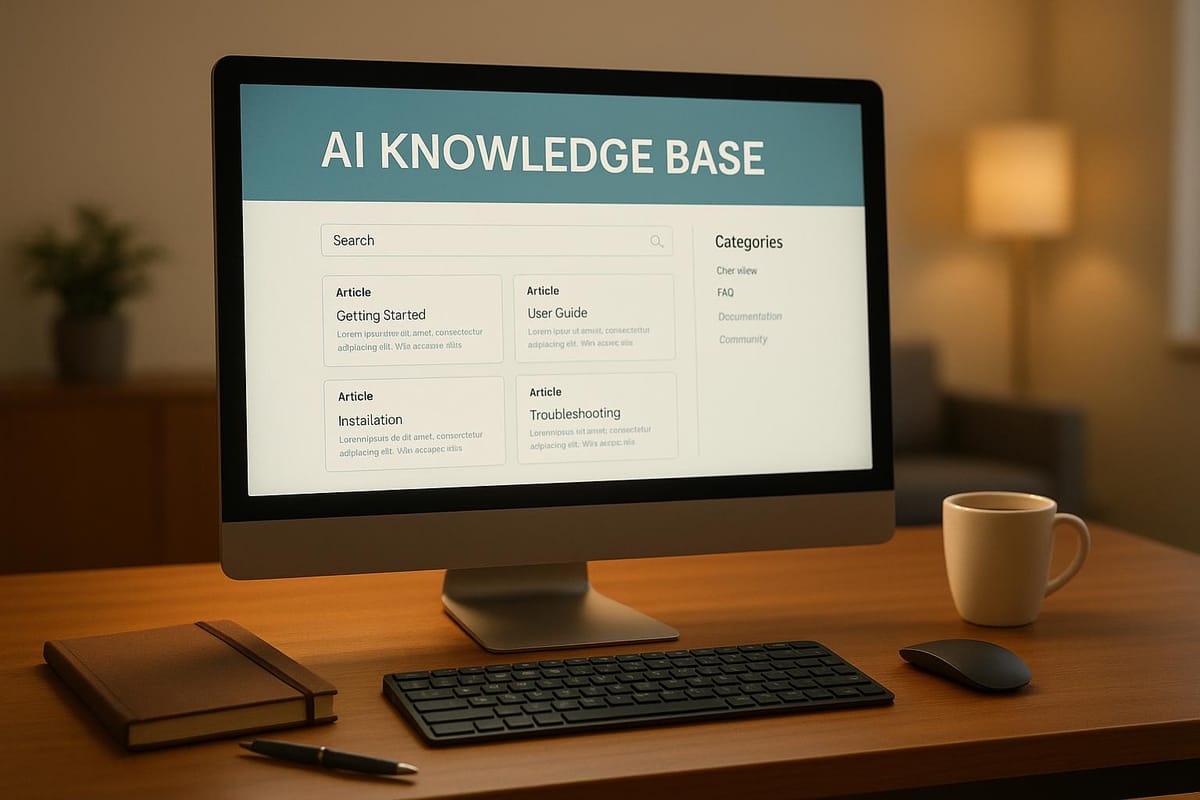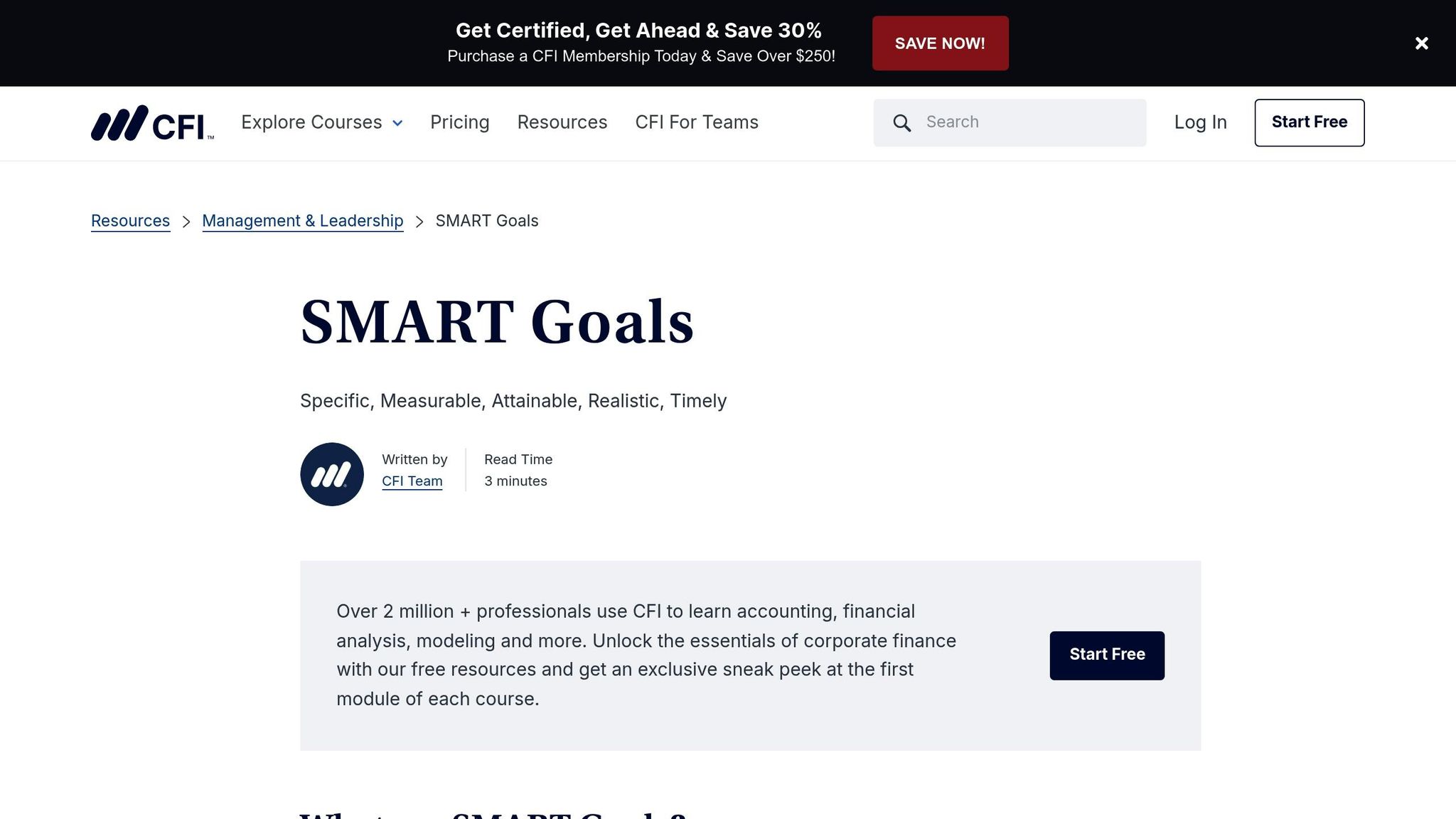10 Tips for AI Knowledge Base Optimization
Optimize your AI knowledge base with clear organization, focused content, and data-driven updates to enhance customer support and efficiency.

AI-powered knowledge bases streamline customer support by organizing content, automating tasks, and improving over time. Here's how to optimize yours:
- Organize Content Clearly: Create categories, subcategories, and consistent tags for easy navigation.
- Focus on FAQs: Start with content addressing common customer questions.
- Centralize Information: Keep all content in one place for better AI training and updates.
- Regularly Review Content: Ensure accuracy, relevance, and fill gaps based on user needs.
- Set Measurable Goals: Use KPIs like resolution rates and search success to track progress.
- Format for AI: Use clear headings, short paragraphs, and metadata to improve AI processing.
- Schedule Updates: Automate reviews and maintain a routine for consistent updates.
- Leverage Data: Use analytics to identify gaps, track performance, and improve content.
- Prepare Quality Training Data: Use varied, accurate, and well-structured content for AI training.
- Choose the Right Tools: Look for AI tools with content creation, analytics, and integration features.
These steps help improve customer experience, reduce support workload, and enhance AI accuracy. Tools like HelpJam can simplify this process with features like AI Copilot, analytics, and multilingual support. Start small, measure results, and refine continuously.
1. Build a Clear Content Structure
Creating a well-organized content structure is crucial for an effective AI-powered knowledge base. Here's how to set up a system that works smoothly and grows with your needs.
Start by defining clear categories to cover all major topics. Each item should have a designated category for easy indexing and retrieval.
Steps to Build Your Structure:
- Create Main Categories: Start with broad categories that cover your key topics. For instance, with HelpJam, you could organize content into groups like "Getting Started", "Account Management", and "Advanced Features."
- Add Subcategories: Break down main categories into more specific topics. This hierarchy helps AI understand how content connects, improving search accuracy and recommendations.
- Use Consistent Tags: Apply a standardized tagging system to link related content across categories. This makes it easier for AI to suggest relevant articles and refine search results.
HelpJam's AI Copilot simplifies article organization, ensuring your knowledge base stays consistent as it grows. Plus, modern AI tools can analyze user behavior and suggest when restructuring might be needed.
Pro Tip: If you have a global audience, use multilingual support when designing your structure. Make sure your categories and tags work seamlessly across all supported languages to deliver a uniform experience for all users.
A strong content structure supports:
- Easy navigation and quick content retrieval
- Growth without losing organization
- Consistency across languages
- Clear connections between related topics
2. Address Common Customer Questions First
Focusing on frequently asked questions not only helps customers quickly find answers but also reduces the workload on your support team. Start by identifying and addressing these recurring customer concerns.
Identify Key Customer Questions
Digging into customer interactions can reveal recurring themes. Look for:
- Search terms customers use often
- Questions that generate the most support tickets
- Topics that consistently confuse users
- Pain points throughout the customer journey
These patterns will guide you in creating clear, targeted answers.
Develop Clear and Helpful Content
Once you've pinpointed the top questions, create content that directly addresses them. To make your answers effective:
- Provide detailed yet straightforward explanations
- Use simple, clear language that works for both people and AI tools
- Add enough context to prevent follow-up questions
Continuously Improve Your Resources
Your knowledge base should grow and adapt as customer needs evolve. Use analytics tools to:
- Track which articles successfully resolve issues
- Identify new, recurring questions
- Analyze chatbot interactions for trends
- Find and fill content gaps
Fine-Tune AI Responses
Incorporate insights from common customer questions to improve your AI tools. This can help:
- Boost the accuracy of AI responses
- Speed up resolution times
- Enhance self-service options for customers
Pro Tip: Regularly review your AI chatbot's conversation logs to uncover new questions and ensure your knowledge base stays relevant to customer needs.
3. Keep All Information in One Place
Centralizing your knowledge base is key to improving AI training, simplifying updates, and gaining better analytics.
Why Centralization Matters
Bringing everything into one place offers clear advantages:
- Better AI Training: A unified dataset ensures AI delivers more accurate and consistent responses.
- Easier Updates: Managing a single source simplifies content changes and keeps everything up to date.
- Sharper Analytics: Consolidated data provides insights into user behavior and content effectiveness.
Building an Organized Knowledge Base
To enhance AI performance, centralize your information while maintaining a clear structure:
- Content Categories: Stick to the category hierarchy you created earlier (see Section 1). Tools like HelpJam allow unlimited categories within a structured framework.
- Multilingual Support: From the start, make sure your system supports multiple languages so AI can handle and serve content accurately.
- Access Controls: Balance security and accessibility by setting up both public and private knowledge bases.
Technical Tips for AI Optimization
Pay attention to these technical aspects to get the most out of your centralized system:
- Custom Domain Integration: Use your branded domain for a consistent user experience.
- SEO Optimization: Fine-tune your pages to make content easier to find and categorize.
- Global CDN Support: A global CDN speeds up page loads, improving both user experience and AI efficiency.
Tracking Centralization Success
Use these metrics to measure how well your centralized knowledge base is performing:
| Metric | What to Monitor | Why It Matters |
|---|---|---|
| Response Accuracy | How precise AI chatbot responses are | Shows how well-organized and effective content is |
| Search Success Rate | How often user queries are resolved | Reflects the quality of your content structure |
| Access Speed | Page load times | Impacts user experience and AI performance |
| User Engagement | Time users spend on articles | Indicates how accessible and relevant content is |
4. Review Existing Content
Keeping your AI's data accurate and up-to-date requires regular content reviews.
How to Review Content Effectively
Accuracy Matters
- Double-check technical details and procedures.
- Ensure links and references are still valid.
- Replace outdated terminology with current language.
Stay Relevant
- Track user search trends and adjust content accordingly.
- Look at engagement metrics to identify underperforming articles.
- Highlight and update topics that are gaining traction.
- Remove content that no longer serves a purpose.
Once accuracy and relevance are addressed, make sure the content is as detailed as it needs to be.
Fill in the Gaps
- Add missing information.
- Expand tutorials to address common follow-up questions.
- Refresh screenshots and visuals to align with current interfaces.
Incorporating these practices ensures your content remains useful and AI-ready.
AI-Specific Tips for Content Reviews
When optimizing content for AI, focus on these areas:
Organized Data
- Keep formatting consistent across all articles.
- Add relevant metadata to improve AI training.
Clear Language
- Use consistent terminology throughout.
- Avoid vague or ambiguous phrasing.
- Include common variations of terms to improve searchability.
- Structure responses to align with natural language processing needs.
Platforms like HelpJam offer tools to streamline this process. They can flag articles needing updates based on user activity and search data. Plus, the system can automatically alert you to review content that hasn’t been updated within your chosen timeframe.
Set a Review Schedule
Consistency is key, so establish a routine:
- Daily: Review user feedback and check AI response accuracy.
- Weekly: Update high-traffic articles and focus on trending topics.
- Monthly: Identify content gaps and fine-tune performance metrics.
- Quarterly: Conduct a full evaluation to clean up and enhance your knowledge base.
This structured approach ensures your content stays relevant and effective for both users and AI systems.
5. Set Clear Objectives
Set goals that are specific and measurable to align with your support strategy. These objectives will guide the process of improving your knowledge base and overall support effectiveness.
Define Key Performance Indicators (KPIs)
Track metrics that directly reflect how effective your support is. Some key examples include:
- Resolution Rate: The percentage of customer queries resolved using AI-powered knowledge base articles without needing human assistance.
- Search Success Rate: The frequency at which users find relevant articles on their first search attempt.
- Article Performance: Metrics like user engagement and feedback for individual articles.
- Support Volume Distribution: The proportion of support requests handled by AI versus those requiring human intervention.
Establish SMART Goals

Use the SMART framework to structure your objectives. Here's how it applies:
| Component | Example Application |
|---|---|
| Specific | Focus on improving first-contact resolution through AI-powered knowledge base tools. |
| Measurable | Set a target for a high percentage of successful article searches. |
| Achievable | Base goals on your current performance and available resources. |
| Relevant | Ensure objectives align with broader customer support goals. |
| Time-bound | Plan for quarterly reviews and updates to measure progress. |
Focus Areas for Optimization
Content Coverage
- Use search data to identify knowledge gaps.
- Create article clusters around frequently asked questions and common issues.
- Address language and localization needs to cater to a diverse audience.
User Experience
- Improve search functionality to help users find content faster.
- Organize articles to match natural conversation flows.
- Customize branding to maintain a consistent look and feel.
Performance Tracking
Leverage analytics tools to monitor metrics like:
- Average resolution time
- User satisfaction scores
- Search query success rates
- Engagement levels with individual articles
Implementation Strategy
- Baseline Assessment: Start by documenting your current metrics and identifying areas for improvement.
- Priority Setting: Focus on the most pressing issues first. For example, optimize knowledge base sections that receive the highest volume of support queries.
- Regular Evaluation: Build a routine to ensure continuous improvement:
- Conduct weekly performance reviews.
- Analyze content gaps monthly.
- Reassess goals quarterly to stay on track.
Tools like HelpJam's analytics suite can provide real-time insights into user behavior, helping you refine your strategy. Its AI Copilot feature also ensures consistency and quality in article creation, making it easier to meet your objectives.
6. Format Articles for AI Reading
Building on the strategies for structuring content, formatting articles for AI ensures they are both easy for machines to process and engaging for users.
The goal is to structure your content so that AI systems can efficiently parse it while maintaining a natural flow for readers.
Optimize Document Structure
To make your articles AI-friendly, focus on:
- Clear headings: Use H2 and H3 tags to outline main topics and subtopics.
- Short paragraphs: Keep content concise and focused on a single idea.
- Relevant metadata: Add tags and categories that help AI understand the context.
- Consistent styling: Apply uniform formatting throughout the article.
Content Organization Best Practices
How you organize your content plays a big role in how effectively AI can process and retrieve information. Here's a quick breakdown:
| Element | Purpose | Implementation |
|---|---|---|
| Headers | Define hierarchy | Use for main topics and subtopics |
| Paragraphs | Ensure information flow | Focus on one idea per paragraph |
| Metadata | Aid AI understanding | Add relevant tags and categories |
| Formatting | Improve readability | Use consistent styles and spacing |
These practices not only help AI systems but also make your content easier for humans to navigate.
Enhance AI Processing
Once your content is well-structured, advanced AI tools can further refine its presentation. For example, tools like HelpJam's AI Copilot can:
- Generate structured content suggestions.
- Support multiple languages.
- Integrate rich media with proper context.
Implement Smart Formatting
To maximize the impact of your content:
- Naturally incorporate relevant keywords.
- Maintain consistent formatting across the article.
- Properly integrate multimedia elements like images and videos.
Leverage AI Tools
HelpJam's rich text editor can simplify formatting by suggesting improvements such as:
- Ensuring uniform styling across sections.
- Organizing information logically.
- Supporting multimedia integration seamlessly.
Additionally, analytics can provide insights into how your formatted content performs, helping you make data-driven adjustments for better results.
7. Update Content on Schedule
Keeping your AI-powered knowledge base up-to-date ensures accuracy and relevance for users.
Automate Content Reviews
HelpJam's AI system simplifies tracking content freshness by:
- Automatically indexing articles to check if they're current
- Scanning customer interactions to spot outdated information
- Identifying knowledge gaps based on user search patterns
Build a Content Update Plan
Set up a structured schedule to maintain high-quality content:
| Update Type | Frequency | Focus Areas |
|---|---|---|
| Quick Review | Weekly | Address user feedback and search trends |
| Deep Analysis | Monthly | Ensure content accuracy and completeness |
| Full Audit | Quarterly | Align content with strategy and identify gaps |
Use AI to Simplify Updates
AI tools make content maintenance more efficient by offering:
- Summaries of existing content
- Automated response generation
- Key point extraction
- Multi-language capabilities
Track Performance Metrics
Monitor these key indicators to guide updates:
- Success rates for user searches
- Engagement levels with articles
- Customer feedback ratings
- Trends in support ticket topics
This data helps refine your update process.
AI-Powered Content Creation
Enhance content creation with AI tools that:
- Suggest new content ideas
- Rephrase and improve existing articles
- Highlight sections that need updating
Optimize with Smart Workflows
Streamline your content updates by following these steps:
- Analyze performance data to identify gaps.
- Use AI tools to make updates faster and more precise.
- Ensure updates align with what users are looking for.
8. Measure Success with Data
Use HelpJam's analytics to keep an eye on key metrics and fine-tune your AI knowledge base. As your knowledge base grows, tracking its performance ensures you're making informed improvements.
Track Key User Metrics
Keep tabs on these important metrics to see how users interact with your knowledge base:
| Metric Type | Metrics Captured | Why It Matters |
|---|---|---|
| Search Behavior | Search terms, failed queries | Pinpoints content gaps |
| Content Performance | Article views, time spent | Highlights content relevance |
| Resolution Rate | Successful self-service cases | Evaluates how effective it is |
| User Feedback | Ratings, comments | Provides direct insights from users |
Understand Search Patterns
HelpJam's analytics tools reveal frequent search terms, failed queries, peak usage times, and common navigation trends. These insights help identify where users struggle and what they need most.
Keep an Eye on Resolution Metrics
- Track self-service success: See how well users are solving issues on their own.
- Review response times: Spot potential bottlenecks in navigation or content delivery.
- Analyze support tickets: Identify areas where your knowledge base might be falling short.
Use AI-Powered Insights
HelpJam's advanced analytics take things further by helping you:
- Identify trending topics users are searching for
- Spot outdated content that needs attention
- Evaluate the performance of multilingual content
- Measure how AI-driven changes are improving outcomes
Make Data-Driven Updates
Here’s how to put your analytics to work:
- Check search analytics weekly to find new content opportunities.
- Use user feedback to refine and improve existing articles.
- Monitor resolution rates to evaluate AI's effectiveness.
- Study conversation patterns to optimize your content layout.
These steps will help you fine-tune your support strategy and keep your knowledge base running smoothly.
9. Prepare Quality Training Data
Building an effective AI knowledge base starts with well-prepared training data. HelpJam simplifies the process by integrating multiple content sources into AI chatbot training.
Use Varied Content Sources
Incorporate different types of content to create a strong knowledge base:
| Content Type | Purpose | Best Practices |
|---|---|---|
| Knowledge Base Articles | Central information hub | Organize with clear headers and sections |
| PDF Documents | In-depth documentation | Convert files to searchable formats |
| Web Pages | Current resources | Provide access to the full sitemap |
| Customer Conversations | Context from real users | Analyze for interaction patterns |
Focus on Data Accuracy
To ensure the AI system learns effectively:
- Review and update all content sources regularly.
- Monitor how the AI processes and interprets data.
- Periodically refresh training materials, incorporating:
- Feedback from customer interactions
- Updates reflecting industry trends or changes
After verifying accuracy, structure the data for smooth AI processing.
Structure Content for Clarity
Make your training data easy for AI to understand:
- Divide complex topics into smaller, manageable sections.
- Use consistent language and terminology across all materials.
- Organize content with clear headers and subheaders.
Analyze Conversations for Insights
Once your training data is ready, dive into customer conversations to fine-tune AI responses. HelpJam's AI tools can assist by:
- Spotting common question patterns
- Identifying gaps in the knowledge base
- Enhancing the accuracy of responses
- Prioritizing content updates or creation
Support Multiple Languages
If your AI system needs to work across languages:
- Begin by preparing content in your primary language.
- Utilize AI-powered translation tools for accurate results.
- Validate translations for cultural relevance and local terms.
- Test the AI's responses in each supported language.
10. Select Effective AI Tools
Choosing the right AI tools can make a big difference in how well your support operations run. Building on earlier tips, this section focuses on picking tools that can improve your knowledge base while being easy to use and effective.
Features to Look For
When assessing AI tools for managing your knowledge base, pay attention to these important features:
| Feature Category | Key Capabilities | Benefits |
|---|---|---|
| Content Creation | AI-powered text editor, translation tools | Speeds up content creation processes |
| Customer Support | AI chatbot integrated with knowledge base | Provides 24/7 automated assistance |
| Analytics | Performance tracking, user behavior insights | Highlights areas for content updates |
| Customization | Branded design, custom domain options | Maintains a consistent brand image |
| Integration | Works seamlessly with existing workflows | Simplifies overall operations |
Make the Most of AI Automation
Modern AI tools can take your knowledge base management to the next level by:
- Using AI editors for tasks like content creation, translation, and optimization.
- Feeding documentation into the AI system to keep it learning and improving.
- Tracking article performance to spot gaps or areas needing updates.
Scale as You Grow
Tools like HelpJam offer flexible storage options to match your needs:
- 10GB for small teams
- 50GB for growing businesses
- Unlimited storage for enterprise-level demands
This flexibility ensures your tool grows with your business.
Keep an Eye on Resource Usage
Efficient use of AI resources is key. For example, HelpJam's Growth plan includes 3 million AI credits per month, offering ample capacity for managing your knowledge base effectively.
Prioritize Integration
Once you've optimized your resource usage, make sure your tool integrates well with other systems:
- Knowledge Base: Automatically index articles to improve AI training.
- Customer Support: Connect in real time with chat and ticket systems.
- Analytics: Access detailed performance tracking and reporting.
Conclusion
Improving your AI knowledge base is key to delivering better support and streamlining your processes. By applying the ten tips shared in this guide, you can build a well-organized, user-friendly system that works seamlessly for both your customers and AI tools.
Here’s how a well-structured knowledge base can make a difference:
| Category | Benefits |
|---|---|
| Customer Experience | Faster answers, 24/7 support availability |
| Operational Efficiency | Fewer support tickets, easier content updates |
| AI Performance | Improved accuracy, better responses |
| Team Productivity | Easier content creation, automated translations |
Advanced tools like HelpJam's AI Copilot take these benefits further by automating content management and offering real-time analytics.
To get the most out of your knowledge base:
- Keep your content organized and review it regularly.
- Use AI to simplify content creation and support multiple languages.
- Rely on data to continuously refine and improve your system.
Choosing the right tools and following a structured, data-focused approach is essential. Scalable solutions, starting at $49 per month, make advanced AI features accessible to businesses of all sizes.
"Deliver exceptional customer support using our AI Platform" - HelpJam
FAQs
What steps can I take to keep my AI-powered knowledge base accurate and up-to-date?
To keep your AI-powered knowledge base accurate and up-to-date, focus on three key areas:
- Regular Updates: Continuously provide your AI with the latest information by updating your knowledge base content, ensuring it reflects current policies, products, or services.
- Monitor User Interactions: Analyze customer interactions with your AI to identify common questions or gaps in knowledge, then adjust content accordingly to improve accuracy and relevance.
- Leverage Analytics: Use performance data to track how well your knowledge base meets user needs. This helps you refine content and ensure your AI provides helpful, timely responses.
By consistently maintaining and optimizing your knowledge base, you can enhance both customer satisfaction and support efficiency.
What KPIs should I monitor to evaluate the effectiveness of my AI-powered knowledge base?
To assess the performance of your AI-powered knowledge base, focus on tracking key performance indicators (KPIs) like:
- Customer satisfaction (CSAT): Measure how happy users are with the information provided.
- Resolution time: Track how quickly users find answers to their questions.
- Search success rate: Monitor how often users successfully locate the information they need.
These metrics help identify areas for improvement and ensure your knowledge base meets user needs effectively. Additionally, analyzing customer searches and identifying content gaps can guide your strategy for creating more helpful and relevant articles.
How can I use AI to improve the multilingual functionality of my knowledge base?
AI can significantly enhance the multilingual capabilities of your knowledge base by streamlining translation processes and ensuring content consistency across languages. With AI-powered tools, you can automatically translate articles while maintaining accuracy and tone, making your knowledge base accessible to a global audience.
For example, platforms like HelpJam provide a multilingual knowledge base feature that simplifies content management in multiple languages. By leveraging AI, you can deliver a seamless, localized experience for your users, ensuring they find relevant information quickly and easily, no matter their preferred language.





